Studio Visit
In Their ‘Epic’ Lofted Studio, Artist Baseera Khan Paints, Collages, Draws, and Dreams
Take a peek inside the artist's Long Island City studio.
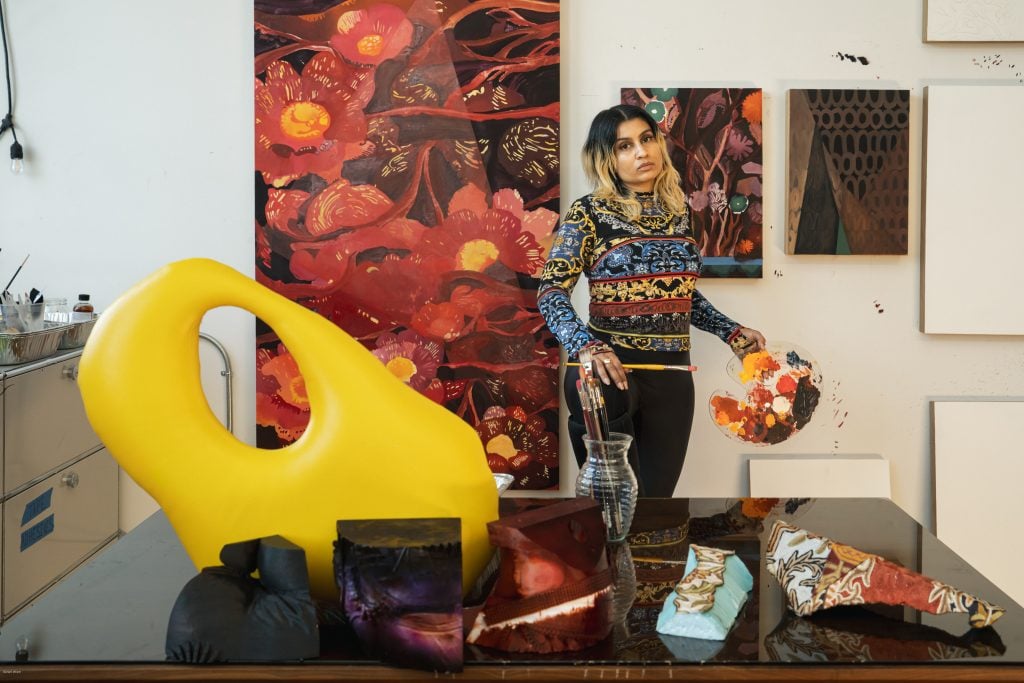
Take a peek inside the artist's Long Island City studio.

Jo Lawson-Tancred

Baseera Khan’s expansive conceptual practice incorporates painting, large-scale installation, performance, and video to address broad socio-political issues like surveillance and invisible labor, as well as highly personal themes, like their identity as a Muslim queer person born in Texas. A 3D-printed acrylic scan of Khan’s own body, inspired by representations of the Buddhist deity Dakini, was the subject of a solo show at the Hirshhorn Museum last year.
“I am feeling super emotional right now,” they said about their working process in late 2023. “New paintings are giving me an outlet to contribute to making work at a time that feels very dark and twisted.” Their studio is a place of solace where Khan can channel these responses to the world using a range of cultural reference points, from the Quran to Kashmir prayer rugs.
“Being an artist is always about shape-making in a world where that specific shape has not yet been made,” they said. “At the end of the day, art is a shape, whether it is physical or mental. Art is the origin of thought and thought shapes us—it takes up space. So, most of my activities involve being in my head and dreaming up shapes, material positionality, and geo-poetics.”
Following the installation last year of Painful Arc II (Shoulder-High) (2023) on the High Line, where it will remain through May, Khan is currently preparing for an upcoming solo exhibition at Simone Subal Gallery in March. They took a quick break from their busy schedule to show us around their studio in Long Island City.
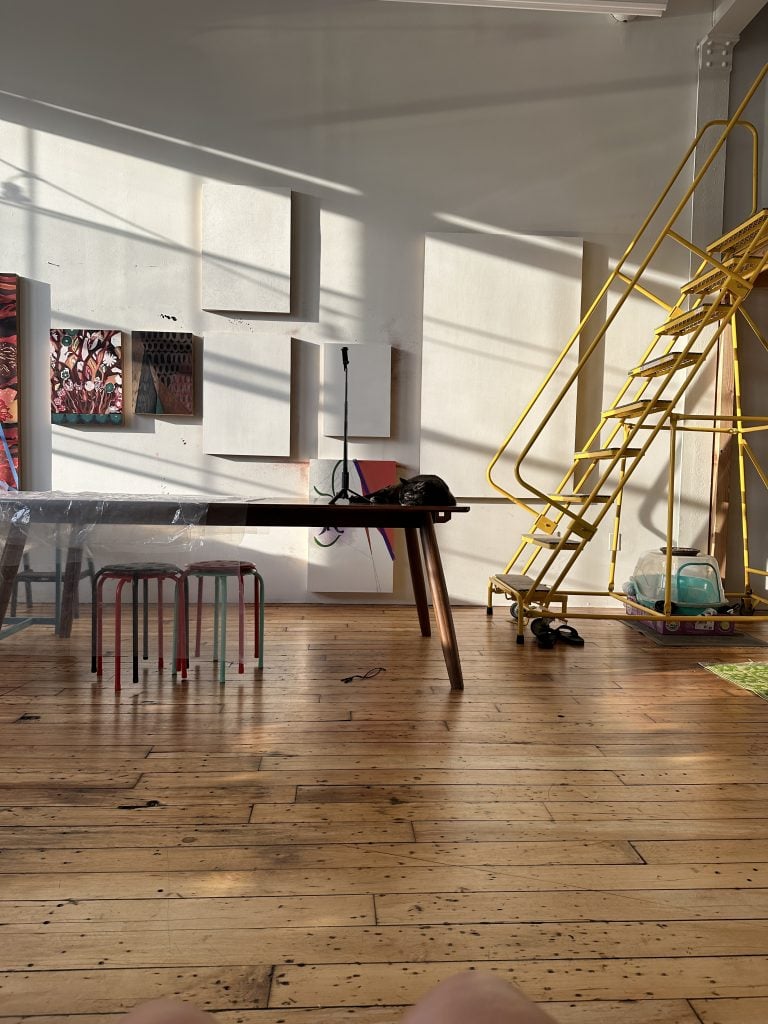
Courtesy of Baseera Khan.
Tell us about your studio.
My studio is a very special place and one that has never been separated from my home life. Since mid-2023, however, I took the leap into renting a space fully dedicated to the sole purpose of making art. I was once advised that my personality is always in the clouds, so why not take a studio that reflects this vision of blur and height. The studio is situated on a third floor walk-up of an old silk factory in Long Island City with manual elevators, old wood panel flooring, and huge cased windows over looking the upper east side of Manhattan. It is truly epic.
How many hours do you typically spend in the studio?
The short answer is I am at work all the time, unless I look you in the eyes and say, can we please not work right now?
I wake up every morning and work through the admin and scheduling of my practice; archiving, writing, emailing, researching, and drafting test prototypes via Photoshop, Illustrator, or InDesign. While I do this, I’m making coffee, protein shakes, feeding the cat, watering the plants, cleaning up mini messes. I have a great disdain for admin, but at the same time I am quite good at it.
By noon I am usually perked, relaxed, and organized enough to start the active making and labor of my practice. It is hard to put this portion of my practice into measurements of time; it is more about losing time. If I am not careful, I can make work without basic food and sleep patterns. There are times of the year where I reverse the process of admin care, due to teaching schedules or gym, and extracurricular activities. If I work really hard to protect my time? I can be up by 6 a.m. or 7 a.m. to work on labor intensive exercises such as painting, writing, drawing, or sewing—the exercises that require not just physical but hugely mental and intuitive energy.
What is the first thing you do when you walk into your studio (after turning on the lights)?
I have the great pleasure of walking to work these days. On the walk over to the studio, I start making a desired list of what needs to be done by the end of day. When I enter the studio, what I do depends on why I am there. My practice is expansive: I paint, I sew, I cut, I build, I draw, I collage, I frame, I edit, I write, I sing, I dream. Sometimes I pick up a broom, or watering can for the plants, wash the dishes from the day before. I like the idea of cleaning, setting, and curing a space before I start working.
Sometimes I feel lazy or sluggish so I use my kettle bells, foam roller, or TRX machine to stimulate my mind. I work out a lot and will leave the studio so that I have time to keep up my strength training. In my head, training my body to be strong is a part of my practice, and I have a deep desire to bring other artists to the gym with me to build our strength together.
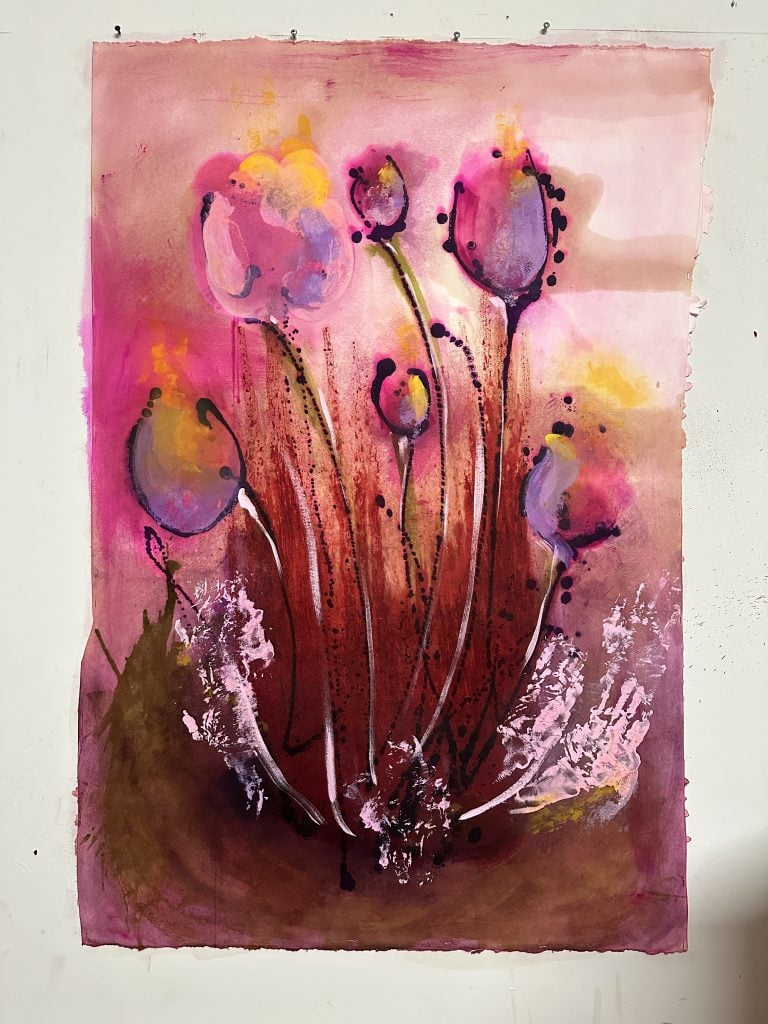
Courtesy of Baseera Khan.
What are you working on right now?
I am translating the language of color, flora, and fauna. The new work is exploring the traditions of oil painting and ink washes for a more emotional hands-on translation of the flora and fauna on traditional rugs from Kashmir. I am also using some very strange materials in the mix. I often use materials that seem to be inscribed in my history or heritage: examples are hair, crude oil, silk, rugs, cotton, dirt, flowers, coffee, sand, deserts, spices, yoga, curry, turmeric, patience, and tea.
I have a group show in February at North Carolina Museum of Art, and a solo show coming up in March at Simone Subal Gallery. All will be revealed then.
What tool or art supply do you enjoy working with the most, and why?
My heart. But for real, I use so many different materials and often have work fabricated too, so I really rely on my heart to tell me what’s good—my heart is my favorite tool. I do a lot to protect my favorite tool. I use sound to stimulate and open up my creativity. I watch artist lectures and documentaries on YouTube. At the moment, I am watching The Andy Warhol Diaries. It’s wild to see certain scenes filmed at the Brooklyn Museum while my exhibition was still installed right next to Andy Warhol on the fourth floor, it feels like I am always close to something chimerical and deep.
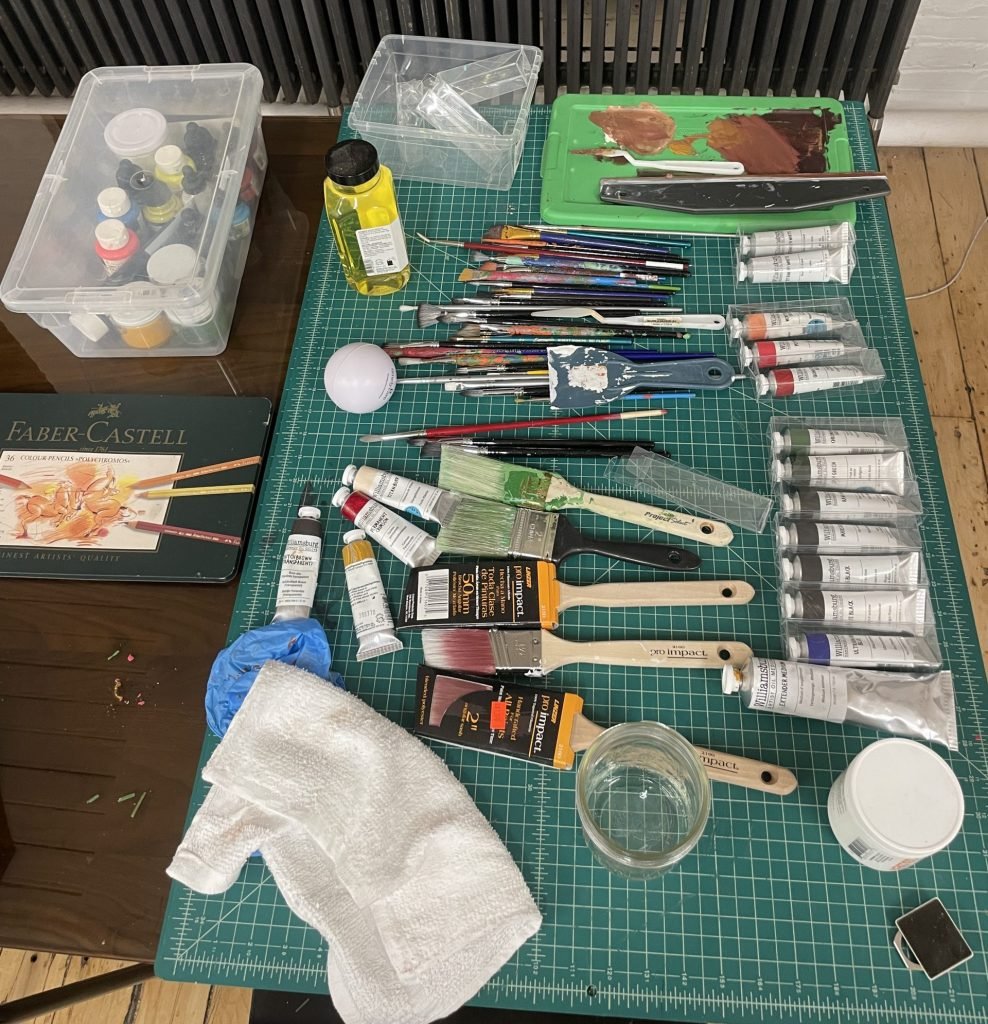
Courtesy of Baseera Khan.
What kind of atmosphere do you prefer when you work?
I like it quiet, and clean spaces. I use my sound-canceling headphones a lot. I do sometimes listen to recorded street noise, or instrument-based music.
What images or objects do you look at while you work?
I look out of my widows and watch the afternoon light strike the primary wall that I work on. Looking at other people’s work is very important to me, and mostly gives me courage to keep making my own work. In these last days as I finish this interview, we lost Pope.L. I can say I have a ton of artist books in my studio. His book in particular I go to quite often. He was a cowboy in the art world, a pure soul who was willing to experiment and ask absurd questions that provided profound ways of seeing.
I bought his book when I was in undergraduate school at the University of North Texas around 2002. It took everything I had and a bag of chips to buy this book, but if I can afford it, I usually try to acquire the monograph books. I am able to visit them as often as I please and learn something new.
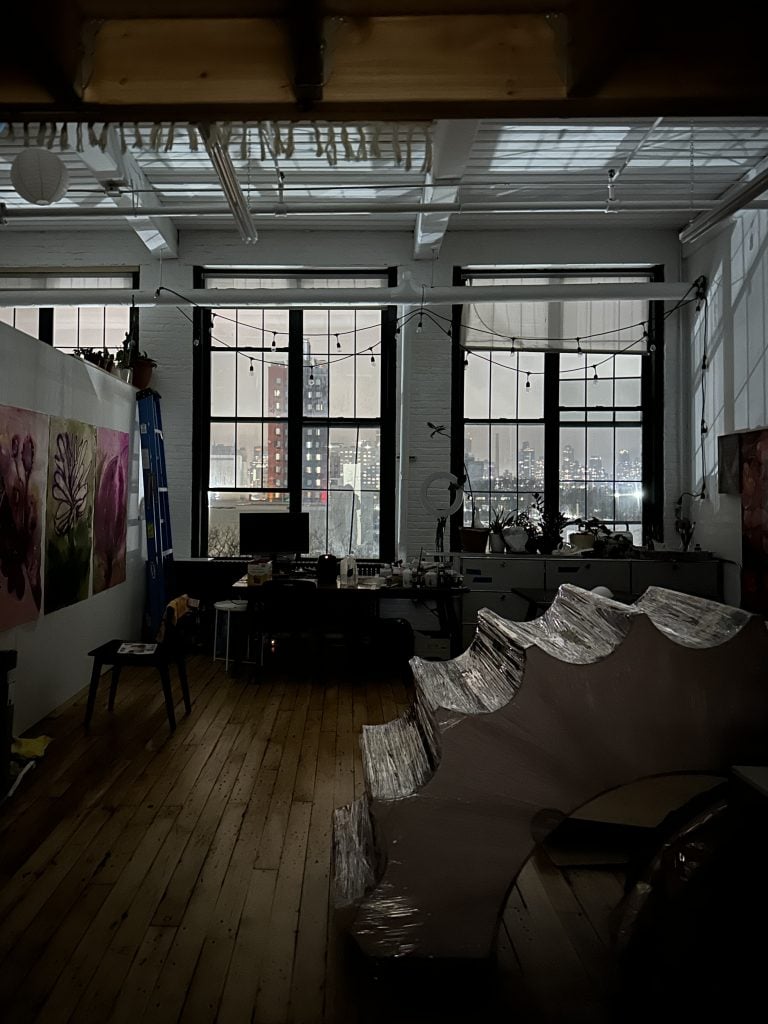
Courtesy of Baseera Khan.
What’s the last museum exhibition or gallery show you saw that really affected you and why?
When I was in Paris late October 2023, I saw a performance by Anthea Hamilton at the Centre Pompidou during Decade of Emotion. She staged a fictional music group, inspired by 1960s and 1970s prog rock. It was about being vulnerable and it offered a perfect explanation of how hard it is to make art.
On the home front, my family came into town in November and we all went to the Guggenheim to see Going Dark organized by Ashley James. There were so many works exhibited that brought my sense of wonder back; it helped that so many of my colleagues and art heroes in this show. At first, I was sad to not be a part of the group, but it’s hard to be sad about these things for long. Every floor was stunning and celebration of great work.
Lastly, I was at Miami Basel this year and paused at Chakaia Booker’s American flag, made from old tires and other found objects. This piece kind of had me tearing up; perhaps I was just tired and my eyes hurt from all the lights and fanfare.
Is there anything in your studio that a visitor might find surprising?
I think what is surprising about the space is how domestic it feels. I have created small sections for dining, resting, playing music. I have a small wood shop, an area just for painting and sewing, and a lofted area to get away to read and collage.

Courtesy of Baseera Khan.
What have been some media or themes you’ve been particularly interested in exploring lately?
I am exploring the shapes of color that make up familiar objects, the feelings that color is capable of sharing. I am looking at how to put together abstract forms of color on paper or wood panels to make a flower, or a landscape, for example. I’m also looking to reveal patterns and moments of repetition.
I am looking to Tantra meditation non-paintings from the 17th century of Rajasthan, and revisiting textiles from Rajasthan and Kashmir in my performance-photography called, “I Arrive in a Place with a High Level of Psychic Distress.” Geometries of colorful acrylic planes were applied over the photographic prints as a healing mechanism. Possessing uncanny affinities to the Tantra non-paintings are a range of 20th-century abstract painters such as Hilma af Klint, Wassily Kandinsky, and Kazimir Malevich, and I enjoy revisiting their works for the new works I am making.
More Trending Stories:
Art Dealers Christina and Emmanuel Di Donna on Their Special Holiday Rituals
Stefanie Heinze Paints Richly Ambiguous Worlds. Collectors Are Obsessed
Inspector Schachter Uncovers Allegations Regarding the Latest Art World Scandal—And It’s a Doozy
Archaeologists Call Foul on the Purported Discovery of a 27,000-Year-Old Pyramid
The Sprawling Legal Dispute Between Yves Bouvier and Dmitry Rybolovlev Is Finally Over